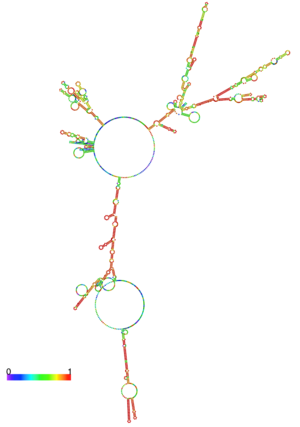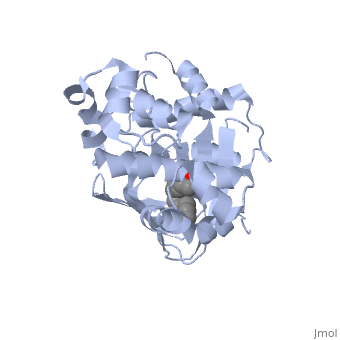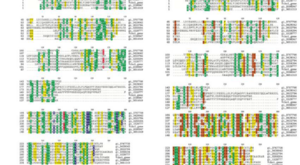ToxT
From Proteopedia
| |||||||||||
Contents |
Further Study
Conclusive results about what activates ToxT itself has not yet been found. The varying activity of ToxT dependent on the presence of cis-palmitoleate or other unsaturated fatty acids represents a detailed method of effective pathogenicity in humans, but may not be a reasonable target for drug treatment. By restricting transcription (and thus translation and protein production) of virulence genes until the bacterium is determined to be in a favorable location for infection, Vibrio cholerae avoids wasting energy producing virulence factors that will just be cleared by the intestine. This is a specific mechanism to ensure that the bacterium also injects CT and TCP where they will do the most damage, perpetuating the infection. [6] Despite the lack of information about what activates ToxT itself, it is understood that the transcription of ctxA and tcpA by vibrio cholerae is sharply reduced in the presence of oleic, linoleic acid, and arachidonic acid, all of which are components of bile. Therefore, one may hypothesize that it may be possible to use the structure of a UFA or SFA to design a small molecule inhibitor of ToxT which may be used to treat or prevent cholera.
Evolution
Vibrio cholerae is a highly diverse species in which some strains are completely harmless, whereas other strains have the capacity to cause global cholera pandemics. It has been discovered that in each epidemic and pandemic strain, there is a chromosomal pathogenicity island (PAI) that is not present in the nonpathogenic strains. The region containing two ToxR-regulated genes (aldA and tagA) is composed of 13kb of previously unidentified DNA. [7]This region is part of a PAI that contains ToxT and a gene cluster a critical colonization factor and TCP. The PAI is 39.5 kb long, contains putative integrase and transposase genes, and inserts near a 10Sa RNA gene. One may infer that the PAI could have originated from a bacteriophage. This PAI was also found in two non-O1/non-O139 (which are both pandemic) sero type strains. Therefore, one may hypothesize that the PAI could be transferred within other strains of Vibrio cholerae.

RNA Structure
Here we have the centroid structure of the mRNA of ToxT. This mRNA is shown in its most stable conformation, with the less stable, higher energy regions in red. The lighter colored regions are more stable and lower in energy.
3D structure of ToxT
Updated on 07-December-2020
3gbg, 4mlo - VcToxT - Vibrio cholerae
6p7t - VcToxT (mutant)
6p7r - VcToxT + fatty acid
6pb9 - VcToxT (mutant) + fatty acid
5suw, 5sux - VcToxT + naphthalene derivative
References
Bentivoglio, M; Pacini, P (1995). "Filippo Pacini: A determined observer". Brain Research Bulletin 38 (2): 161–5. doi:10.1016/0361-9230(95)00083-Q. PMID 7583342
Chiorazzo, G; Michael. Kull F; John. Lowden J; Michael. Pellegrini, Maria. Ronald, K; Taylor. Skorupski, Karen. (2009).“Structure of Vibrio Cholerae ToxT reveals a mechanism for fatty acid regulation of virulence genes.” 10.1073/pnas.0915021107
DiRita VJ, Parsot C, Jander G, Mekalanos JJ (June 1991). "Regulatory cascade controls virulence in Vibrio cholerae". Proc. Natl. Acad. Sci. U.S.A. 88 (12): 5403–7. doi:10.1073/pnas.88.12.5403. PMC 51881. PMID 2052618. http://www.pubmedcentral.nih.gov/articlerender.fcgi?tool=pmcentrez&artid=51881.
Sack DA, Sack RB, Nair GB, Siddique AK (January 2004). "Cholera". Lancet 363 (9404): 223–33. doi:10.1016/S0140-6736(03)15328-7. PMID 14738797.
Klose, E; Karl. Osorio, R; Carlos. Prouty, G; Michael. (2005) “Characterization of functional domains of the Vibrio cholerae virulence regulator ToxT” DOI: 10.1111/j.1365-2958.2005.04897.x
Prevention and control of cholera outbreaks: WHO policy and recommendations, World Health Organization, Regional Office for the Eastern Mediterranean, undated but citing sources from ’07, ’04, ’03, ’04, and ’05.
Bailey, C; Camilla. Boedeker, C; Edgar. Johnson, A; Judith. Kaper, B; James. Karaolis, R; David. Reeves, R; Peter. (1997). “A Vibrio cholerae pathogenicity island associated with epidemic and pandemic strains.” March 17, 1998 vol. 95 no. 6 3134-3139
Proteopedia Page Contributors and Editors (what is this?)
Ingrid Youngworth, Yang Yang, Michal Harel, Alexander Berchansky, Jaime Prilusky


